 |
Right to Life - Environment
Chappaquiddick: The Pathetic Legacy
of Senator Edward Kennedy
Lyle J. Arnold, Jr.
"Edward Kennedy was a wonderful Catholic and is already in heaven." Fr. Mark Hession.' (1) Senator Kennedy "became the greatest United States senator of our time." President Barack Obama. (2)
These two statements about Senator Kennedy give witness to mentalities seemingly gone daft. The blatantly a priori statement by Fr. Hession that Kennedy "is already in heaven" is pure Protestant and arrogant presumptuousness. Obama' s lugubrious statement about the "greatest United States senator" is tantamount to a Catholic saying Paul VI was the greatest Pope, and begs the question if he has any semblance of objectivity about Kennedy's personal history.
The abominable anti-Catholic public voting record of Kennedy is well-known and public. (3) But his dystopian private life parallels the thick catalog of profanations he committed in the public sector. In 1958 he married Joan Bennett, but their marriage was troubled by his womanizing, and they divorced in 1982. In 1992 he married divorcee Victoria Anne Reggie in a civil ceremony.
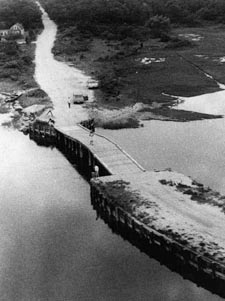
A view of the Chappaquiddick bridge |
But the most disturbing incident in the future Senator's history - revealing a complete lack of character and disregard for life - was Chappaquiddick.
In 1969 Kennedy attended a party on Chappaquiddick, a small island connected by ferry to the town of Edgartown, situated on the adjoining larger island of Martha's Vineyard in Massachusetts. A small ferry crosses Edgartown Harbor carrying vehicles and people a distance of 527 feet.
The party was held at a rented cottage in honor of David Hackett, who had been in charge of the “Boiler Room” where trusted workers compiled intelligence reports on how delegates to the Democratic convention intended to vote. Six married men and six un-married women attended. These Boiler Room Girls had assisted in the 1968 presidential campaign of Kennedy's brother Robert. Kenney's cousin Joseph A. Gargan, who was one of the attendees, stated that all those at the party were "a little bombed, except for Ray LaRosa."
At sometime between 11:30 p.m. on Friday, July 18, and 1:00 a.m. on Saturday, Kennedy and Mary Jo Kopechne, a hauntingly pretty 28-year-old lass, slipped out of the party and got into Kennedy's 1967 Oldsmobile sedan. Mary Jo told no one that she was leaving with Kennedy. Kennedy later testified that at "approximately 11:15 p.m." he had announced that he was about to leave, and Kopechne told him that she also wanted to go and asked if he would be kind enough to drop her back at her hotel (in Edgartown).
Kennedy's chauffeur John Crimmins was at the party, and so the first cloud enters with the question, asked by none other than Richard Drayn, Kennedy's press secretary: "Why had Ted Kennedy driven himself to the ferry when his chauffeur was at the party?" Another cloud appears because Mary Jo left her purse and hotel key at the party.
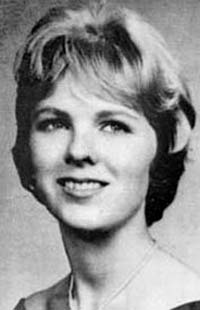
Mary Jo Kopechne, left by Kennedy to her fate |
Kennedy drove his car off the main road (leading to the ferry) and made a turn onto Dike Road. He knew this road led to the beach because on Friday he had twice traveled it for a swim. However, before driving down Dike Road an incident of prime significance occurred. Prior to turning onto Dike Road, Kennedy had driven down Cemetery Road, a single car-width private road. Kennedy stopped the car at this point, but saw Deputy Sheriff Christopher Look (later elected Sheriff ), behind him. Look later testified under oath that this incident happened at "approximately 12:40 a.m. to 12:45 a.m.," contradicting Kennedy's statement on this matter.
The statement of State Police Detective Bernie Flynn on this incident reads:
"I figure we've got a drunk driver, Ted Kennedy. He's with this girl, and he has it in his mind to go down to the beach and make love to her. He's probably driving too fast and he misses the curve and goes into Cemetery Road. He's backing up when he sees this guy in uniform coming towards him. That's panic for the average driver who's been drinking; but here's a United States Senator about to get tagged for driving under (the influence). He doesn't want to get caught with a girl in his car, on a deserted road late at night, with no license (4) and driving drunk on top of it. In his mind, the most important thing is to get away from the situation.
"He doesn't wait around. He takes off down (Dike) road. He's probably looking in the rear-view mirror to see if the cop is following him. He doesn't even see the bridge and bingo! He goes off. He gets out of the car; she doesn't. The poor (expletive) doesn't know what to do. He's thinking, `I want to get back to my house, to my friends ` which is a common reaction. There are houses on Dike Road he could have gone to to report the accident, but he doesn't want to. Because it's the same situation he was trying to get away from at the corner – which turned out to be minor compared to what happened later.
"Now there's been an accident; the girl's probably dead. All the more reason not to go banging on somebody's door in the middle of the night and admit what he was doing. He doesn't want to reveal himself..."
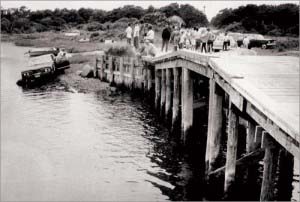
Kennedy's Oldsmobile 88 is dragged from the waters the next day |
After backing out of Cemetery Road, Kennedy followed Dike Road, a narrow, unpaved and unlit road, the .7 mile to Dike Bridge, a wooden bridge with no guard rails, the beach being just beyond the bridge. The car went off the bridge, plunging into Poucha Pond at the location of a tidal channel. The car came to rest with its roof on the bottom of the pond, its front end "angled towards the bridge," with the rear tires at or near the pond level.
Kennedy got out safely, Mary Jo didn't. Kennedy left the scene, first returning to the party, and afterwards going to Edgartown Harbor. He dove in, swam the short distance to Edgartown (a five minute swim), and arrived at his room in the Shiretown Inn about 2:00 a.m. He reported the accident the next morning, about ten hours after the accident. The lack of facts on the case caused Newsweek to report: "When the Senator's closest associates are known to have been powerfully concerned over his indulgent drinking habits, his daredevil driving and his ever-ready eye for a pretty face, (plus the) bafflingly-obscure" police report, much explanation is demanded about this incident.
More black clouds appear in the details. Kennedy stated he made several failed attempts to get Mary Jo out of the car, then gave up and walked the 1.2 miles back to the cottage, about a 23-minute walk. A house with its lights on is so close to the bridge there’s no way you could go down that road and not see that house. Kennedy passed by without going to the house and asking for emergency help. He passed three other houses.
The Chappaquiddick Volunteer Fire Station is only 150 yards from the party cottage, where a red light burned over an unlocked door, with a switch inside that trips a roof-mounted siren. Kennedy did not seek help there either. The Fire Captain later said that if the alarm would have been sounded, "I would have been there in three minutes. And my volunteers and half the people on the island would have shown up within 15 minutes."
The clouds turn cold and black. Kennedy knew that Mary Jo was in the car because he testified he tried numerous times to get her out but was unable. Why? Kennedy was a large-framed man, 6 feet 2 inches, Mary Jo was 5 feet 4 inches and weighed 110 pounds. So why couldn't he get her out?
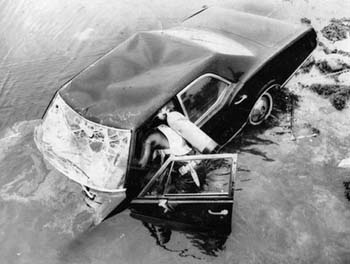
Diver John Farrar brought new facts to light on Mary Jo's last hours |
Then, instead of seeking emergency help. Kennedy - with Mary Jo most probably still alive - returned to the party and contacted the aforementioned Joseph Gargan and former U.S. Massachusetts Attorney General Paul Markham. The three return to the bridge, and Gargan and Markham dove in, trying in vain to get Mary Jo out of the car. At this point the obvious thing to do was call for emergency help. Gargan estimated that as little as 30 minutes had elapsed from the time the car went under.
Kennedy then began to harangue his friends to contrive a story to get himself off the hook, creating scenarios that were as insipid as they were criminal. A shouting match ensued, with Gargan and Markham refusing to be part of a criminal conspiracy. Gargan and Markham insisted aggressively that the accident be reported immediately. The argument ended in a stalemate, and they left the scene, driving Kennedy to the Edgartown Harbor thinking that he would report the accident.
Kennedy dove into the water and swam to his hotel in Edgarton and went to bed. The next morning, he reported the accident after a ten-hour span. It is easy to form a reasonable hypothesis as to why Kennedy avoided involving anyone from officialdom after the accident. They would have taken a blood sample, and since he was a known heavy drinker, he would have faced a manslaughter indictment. (The blood-alcohol level of Mary Jo was .09, meaning she had had as many as five drinks). But why didn't Gargan and Markham call for emergency help? There was still a strong probability that Mary Jo was still alive.
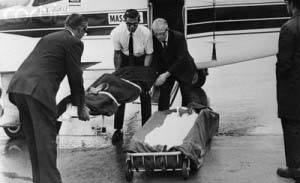
The removal of Kopechne's body - drowned or suffocated? There was no autopsy... |
John Farrar, the scuba diver (head of Search and Rescue) who recovered Kopechne's body the next day helped to clarify the picture. She was in the well of the back seat of the overturned car, and her hands were clasping the backseat and her face was turned upward "to the area of an ultimate airpocket - she didn't drown. She died of suffocation in her own air void ... I could have had her out of that car (alive) twenty-five minutes after I got the call. But (Ted Kennedy) didn't make the call ... She could have been alive a good while after the car went off the bridge . Persons trapped in submerged automobiles had survived up to five hours by breathing a pocket of air ... (and) initially a large amount of air was trapped inside ... (Mary Jo) was alive, easily an hour."
NB Farrar's expert opinion was excluded at the hearing, but Dr. Werner Spitz, deputy chief medical examiner for the state of Maryland, did testify and confirmed Farrar's opinion as being correct.
The official examining doctor stated that Mary Jo drowned, which frontally clashed with the expert opinions of the diver and the mortician in the case, who affirmed that death was not from drowning but from suffocation. The amount of water drawn from the body was too little for a drowning case, and her body was "too buoyant to be full of water." But the examining doctor wouldn't listen because he "didn't want to cause any problems."
Nor, unbelievably, would he request an autopsy. The gears of raw power and immense wealth had meshed. Kennedy received a two-month sentence – which was suspended – for leaving the scene of an accident.
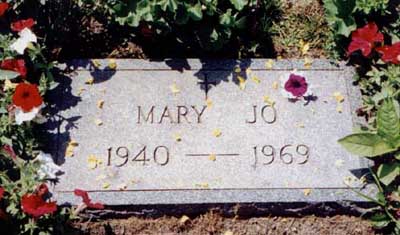
Part of the pathetic legacy of Ted Kennedy |
Former State Police Detective-Lieutenant George Killen, chief of a never-revealed investigation into the death of Mary Jo Kopechne, stated shortly before he died that Senator Kennedy "killed that girl the same as if he put a gun to her head and pulled the trigger." At the inquest Judge Boyle found probable cause that Kennedy had committed a crime, including manslaughter. Yet the District Attorney wouldn't file. (5)
Was Kennedy a "wonderful Catholic," and "the greatest United States senator"? Kennedy's voting record and the Chappaquiddick incident point to a man who had nothing but disdain for the Fifth Commandment. The words of Shakespeare from Henry IV come to mind: "For thou hast lost thy princely privilege with vile participation."
Maybe Kennedy made a good confession, repenting for his voting record, the Chappaquiddick incident, et alii. But people usually die the way they live. Let us hope that Kennedy is the rare exception to that rule...
1 "Public Sin Calls for Public Repentance," Gary L. Morella, posted on Tradition in Action 8-31-09.
2 Contra Costa Times, 8-27-09, page Al.
3. See Morella’s article listed above.
4 Kennedy's driver's license had expired.
5. Fcts from this article were taken from these sources: Leo Damore, Senatorial Privilege – The Chappaquiddick Cover-Up, Washington DC: Regnery Gateway, 1988; "Mary Jo Kopechne: Biography," www.spartacus.schoolnet.co.uk; Wikipedia.

Posted September 14, 2009

Related Topics of Interest
 Kennedy Liked To Joke about Chappaquiddick Kennedy Liked To Joke about Chappaquiddick
 Public Sin Calls for Public Repentance Public Sin Calls for Public Repentance
 What Is To Blame for the Demographic Catastrophe? What Is To Blame for the Demographic Catastrophe?
 'Nine Frozen Little Ones Hanging Out' 'Nine Frozen Little Ones Hanging Out'
 Vatican II Inverted the Ends of Matrimony Vatican II Inverted the Ends of Matrimony
 The Fallacy of Roe Vs Wade The Fallacy of Roe Vs Wade
 Ratzinger against Public Sanctions on Abortionists Ratzinger against Public Sanctions on Abortionists

Related Works of Interest
|
|
Right to Life | Cultural | Hot Topics | Home | Books | CDs | Search | Contact Us | Donate

© 2002- Tradition in Action, Inc. All Rights Reserved
|
 |

|